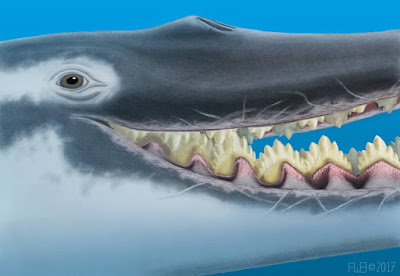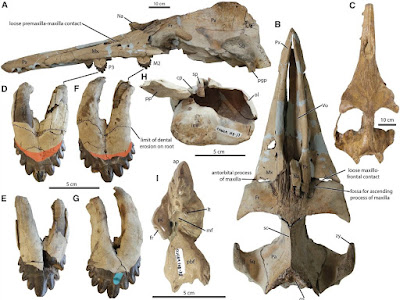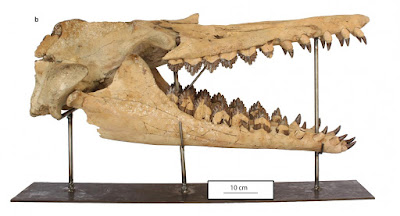 |
| Coronodon havensteini
Geisler, Boessenecker, Brown & Beatty, 2017
|
Highlights
• A new species of 30 million year old whale has been found near Charleston, South Carolina
• This new species is a relative of modern baleen-bearing whales but retains teeth
• Its molars are large, multi-cusped, and overlapping and were used for filter feeding
• Filter feeding evolved before baleen; early whales had teeth and baleen
Summary
As the largest known vertebrates of all time, mysticetes depend on keratinous sieves called baleen to capture enough small prey to sustain their enormous size. The origins of baleen are controversial: one hypothesis suggests that teeth were lost during a suction-feeding stage of mysticete evolution and that baleen evolved thereafter, whereas another suggests that baleen evolved before teeth were lost. Here we report a new species of toothed mysticete, Coronodon havensteini, from the Oligocene of South Carolina that is transitional between raptorial archaeocete whales and modern mysticetes. Although the morphology and wear on its anterior teeth indicate that it captured large prey, its broad, imbricated, multi-cusped lower molars frame narrow slots that were likely used for filter feeding. Coronodon havensteini is a basal, if not the most basal, mysticete, and our analysis suggests that it is representative of an initial stage of mysticete evolution in which teeth were functional analogs to baleen. In later lineages, the diastema between teeth increased—in some cases, markedly so—and may mark a stage at which the balance of the oral fissure shifted from mostly teeth to mostly baleen. When placed in a phylogenetic context, our new taxon indicates that filter feeding was preceded by raptorial feeding and that suction feeding evolved separately within a clade removed from modern baleen whales.
Keywords: Mysticeti; filter feeding; baleen; oligocene; South Carolina; toothed mysticete
Systematics
Order Cetacea
Suborder Mysticeti
Coronodon havensteini gen. et sp. nov.
Holotype: CCNHM 108. Nearly complete, 1.0-m-long skull, mandibles, 14 vertebrae, and partial ribs (Figures 1, 2, and 3; Figures S1–S3; Tables S1 and S2).
Etymology: Coronodon havensteini. Genus is Greek for “crown tooth,” referring to the multi-cusped molars. The species name recognizes Mark Havenstein, who discovered the holotype.
Locality and Age: Wando River near Highway 41 Bridge, South Carolina, Berkeley County. Ashley Formation, Oligocene, uppermost Rupelian.
Diagnosis: Coronodon has the following mysticete synapomorphies: supraoccipital level with temporal fossa (character 25: state 1), broad basioccipital crests (39: 2), all cusps of posterior teeth subequal (99: 1), upturned antorbital process of maxilla (100: 1), and splayed basal cusps on posterior teeth (206: 1). Like some archaeocetes, its rostrum is twisted counterclockwise in anterior view (Figure 3). Coronodon havensteini is unique in having anterior lower molars labially overlapping posterior lower molars. ....

 |
| Coronodon havensteini Geisler, Boessenecker, Brown & Beatty, 2017 |
Jonathan H. Geisler, Robert W. Boessenecker, Mace Brown and Brian L. Beatty. 2017. The Origin of Filter Feeding in Whales. Current Biology. In Press. DOI: 10.1016/j.cub.2017.06.003
Ancient South Carolina whale yields secrets to filter feeding's origins
phy.so/417944795 via @physorg_com




